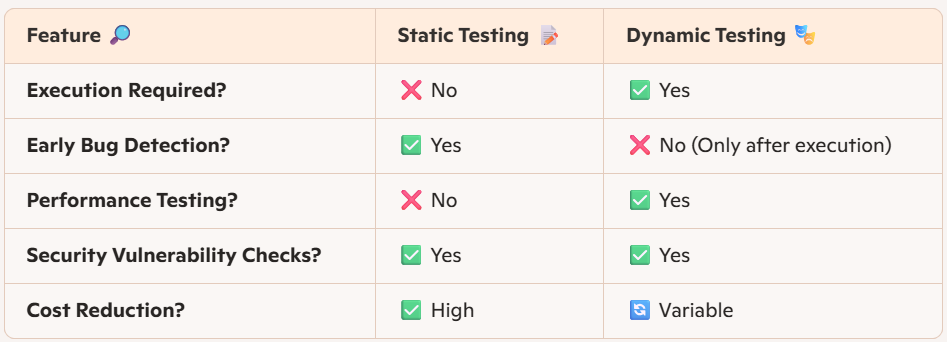 OTHERS
OTHERS Static Testing: The Essential Guide to Early Bug Detection & Software Quality

Introduction: The Costly Bug That Changed Everything
Imagine this: You're working on a software project for months. The launch date is approaching, and everything seems perfect—until a catastrophic bug surfaces at the last minute. The entire system crashes, users flood support with complaints, and suddenly, your reputation is on the line. 😱
What if this could have been avoided?
This is exactly where Static Testing becomes your greatest ally. While most teams focus on finding bugs during execution (dynamic testing), static testing detects critical issues before a single line of code runs! 💡
Let’s explore how this powerful approach can save you time, money, and sleepless nights. 🔥
🛠 What is Static Testing & Why Does It Matter?
📌 Definition & Purpose
Static Testing is a proactive software quality technique that examines the code, documents, and design before execution to detect errors, security risks, and compliance issues.
Unlike Dynamic Testing, which identifies defects while running the application, Static Testing finds flaws early—saving companies thousands of dollars in development costs. 💰
🆚 Static vs. Dynamic Testing: A Quick Comparison

🔎 Static Testing Techniques & Their Power
1️⃣ Code Reviews: The First Line of Defense
Ever seen messy, unstructured code that leads to disaster? Code reviews help catch poor practices before they wreak havoc. ✅
Best Practices:
- Maintain a structured peer review process 👥
- Focus on readability, maintainability, and security 🔐
- Use automated linting tools for consistency
🚀 Reality Check: Skipping code reviews often leads to costly fixes later in development. Avoid it at all costs!
2️⃣ Static Analysis: The Silent Protector of Code Quality
Static Analysis tools automatically scan for vulnerabilities, ensuring compliance with coding standards.
Popular Tools: 🛠
- SonarQube – Detects security flaws & code smells
- Checkstyle – Ensures consistent coding style
- FindBugs – Identifies runtime risks before execution
Pro Tip: Integrate static analysis tools into your CI/CD pipeline to prevent low-quality code from entering production. 🚀
3️⃣ Walkthroughs & Inspections: Spotting Issues Before They Spread
Before finalizing a project, teams conduct structured walkthroughs & inspections to validate the logic and functionality.
🔍 Checklist for Effective Inspections: ✅ Review requirement documents ✅ Verify test cases for completeness ✅ Identify security loopholes
💡 Before/After Impact: 🔴 Before: Teams rushed development without inspections → Bugs emerged after deployment ❌ 🟢 After: Teams used structured static testing → Fewer defects, smoother releases ✅
🚀 How Static Testing Saves Time & Money
💰 Companies waste an average of $5,000 per defect found after deployment. ✅ Static Testing can eliminate up to 85% of bugs before execution, saving both time and resources!
🔑 Key Benefits: ✔ Early Bug Detection – Prevent major failures before they occur ✔ Improved Security – Finds loopholes hackers exploit ✔ Better Code Quality – Enhances maintainability & readability
Reality Check: Skipping static testing costs companies millions in fixes, downtime, and lost user trust.
🛠 Best Practices for Integrating Static Testing Into Your Workflow
🔑 Checklist for Efficient Static Testing: ✔ Automate Static Analysis Tools for code reviews ✔ Conduct peer code reviews regularly ✔ Ensure compliance with security guidelines ✔ Combine Static & Dynamic Testing for full coverage
🚀 Call-to-Action: Start integrating static testing TODAY! Your future self will thank you. 🙌
🗂 FAQ Section: Everything You Need to Know About Static Testing
💡 What is Static Testing?
Static Testing is a quality assurance method that checks the software for defects before execution.
📌 Why is Static Testing Better Than Dynamic Testing?
Static Testing finds bugs early, while Dynamic Testing detects issues after execution, often leading to expensive fixes.
🔐 How Does Static Testing Improve Security?
By scanning code for security flaws before deployment, Static Testing blocks vulnerabilities hackers exploit.
🔎 What Are the Best Static Testing Tools?
Popular tools include SonarQube, Checkstyle, and FindBugs for automated code analysis.
🚀 How Can I Integrate Static Testing in Agile & DevOps?
Implement automated code reviews & static analysis in CI/CD pipelines for continuous quality assurance.
🎯 Final Checklist: Mastering Static Testing Like a Pro
✅ Use Code Reviews to maintain consistency ✅ Implement Static Analysis Tools for automated defect detection ✅ Conduct Structured Walkthroughs to refine requirements ✅ Combine Static & Dynamic Testing for complete coverage ✅ Maintain a QA-centric mindset throughout development
💡 The Takeaway: Static Testing is not an option—it’s a necessity. It eliminates defects before execution, saving companies time, money, and frustration. Start using it today to achieve software excellence! 🚀